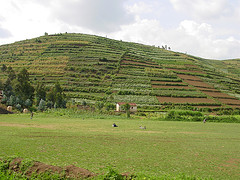Legislation Addressing Conflicts Between Agriculture and Critical Areas Has Significant Implications for Counties and Landowners
 The Washington State Legislature is considering a bill that would establish a new process for addressing the long-standing tension between agricultural activities and the protection of critical areas as required by the State Growth Management Act (GMA). If adopted, the bill (ESHB 1886) would require counties throughout the state to choose between protecting critical areas on agricultural lands either through the existing GMA regulatory process for adopting critical areas ordinances (CAOs) or through a new “Voluntary Stewardship Program.”
The Washington State Legislature is considering a bill that would establish a new process for addressing the long-standing tension between agricultural activities and the protection of critical areas as required by the State Growth Management Act (GMA). If adopted, the bill (ESHB 1886) would require counties throughout the state to choose between protecting critical areas on agricultural lands either through the existing GMA regulatory process for adopting critical areas ordinances (CAOs) or through a new “Voluntary Stewardship Program.”
The Voluntary Stewardship Program is designed to “protect and enhance” critical areas on agricultural lands through voluntary actions by agricultural operators. If a county chooses to participate in the Program, it will be required to identify some or all of the watersheds within the county that will be “participating watersheds” under the Program. Counties that participate in the Program will be eligible for funding and will not be required to implement the Program until adequate funding is provided. Details regarding administration of the Program by the Washington State Conservation Commission and participating counties are outlined in the bill report for ESHB 1886.
Counties participating in the Voluntary Stewardship Program would no longer be required to impose mandatory GMA regulations to protect critical areas affected by agricultural activities on land in participating watersheds. This could provide greater flexibility in balancing protection for critical areas with the goal of maintaining and enhancing the viability of agriculture. However, participation in the Voluntary Stewardship Program will open the door to substantial state-level scrutiny by state agencies, tribes, and other stakeholders – a step that has been vigorously resisted by many counties and the agricultural community. In addition, if local work plans adopted under the Program fail to reach goals and benchmarks for “protection and enhancement” of critical areas, counties may still be faced with mandatory regulatory requirements in the future. Finally, there is significant uncertainty regarding the source and availability of funding for the Program. According to supporting testimony described in the bill report, “state agencies are assuming federal funds will be available to implement the program.”
ESHB 1886 would build on prior legislation and work by the William D. Ruckelshaus Center to address conflicts between agriculture and CAOs. In 2007, the Legislature passed Substitute SSB 5248, which established a three‐year moratorium that prohibited counties and cities from adopting amendments to local CAOs “as they specifically apply to agricultural activities.” That 2007 bill was largely a response to the Washington Supreme Court’s decision in Swinomish Indian Tribal Community v. Western Washington Growth Management Hearings Board, 161 Wn.2d 415 (2007). In that case, the Court rejected the argument that the GMA requires counties to repair degraded habitat – particularly salmon habitat in agricultural areas – and held that the GMA only required no further harm be done to habitat. (The requirement to “protect and enhance” critical areas under ESHB 1886’s Voluntary Stewardship Program goes beyond this baseline requirement under the GMA.)
SSB 5248 also charged the Ruckelshaus Center with examining conflicts between agricultural activities and CAOs and identifying policy options and opportunities to address those conflicts. The Ruckelshaus Center delivered its final report to the Governor and the Legislature in October of 2010. In 2010, the Legislature extended the CAO moratorium by one year, and the moratorium is now set to expire on July 1, 2011.
If ESHB 1886 is adopted, counties will have two years following the effective date of the bill to review and make any necessary revisions to CAOs as they apply to agricultural activities. For counties electing to participate in the Voluntary Stewardship Program, this requirement will not apply to watersheds selected for participation. For counties electing not to participate in the Program, this requirement will apply to all unincorporated areas.
The bill is scheduled for a public hearing in the Senate Committee on Agriculture & Rural Economic Development on March 8 at 1:30 PM.


No comments yet
Start the discussion by using the form below